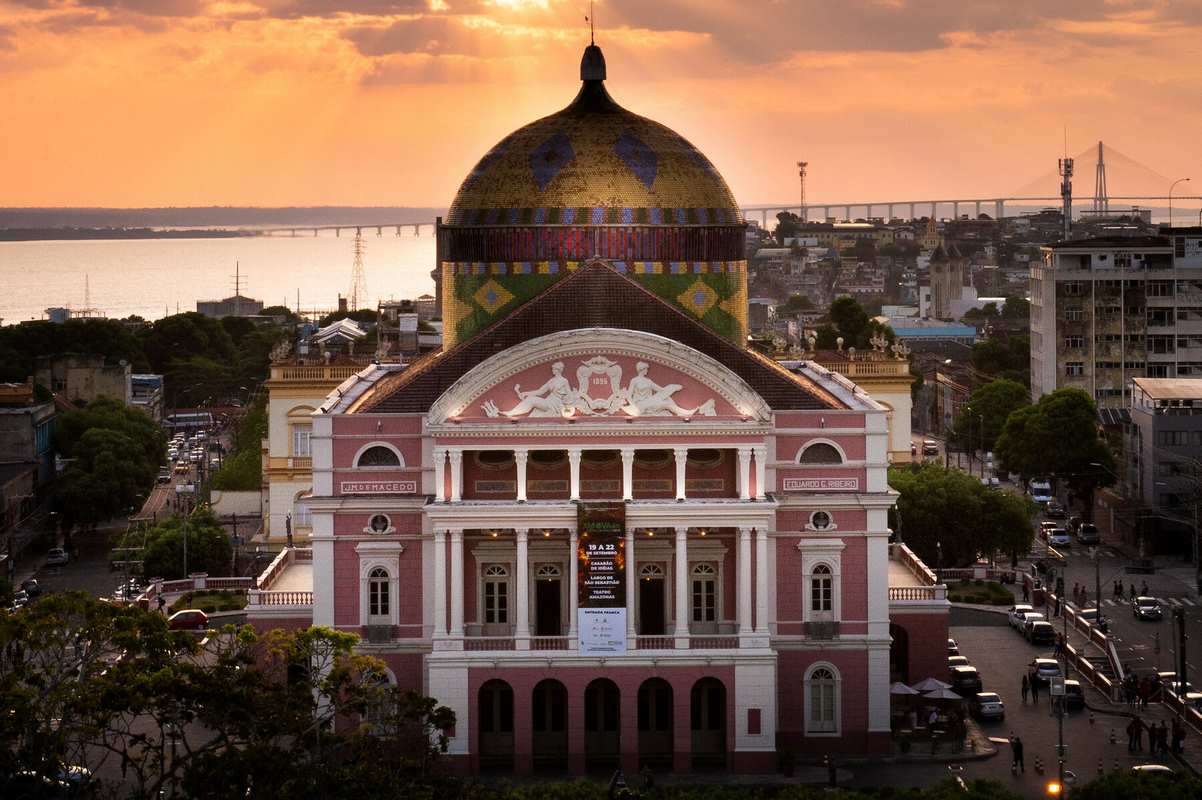127 years ago today, the Teatro Amazonas in Manaus, Brazil, held its first performance during the heyday of the city’s rubber boom. It was voted by Vogue Magazine as the most beautiful opera house in the world, despite being built straight in the heart of the Amazon Rainforest. To debut the theater, celebrated tenor Enrico Caruso came to perform the Italian opera, La Gioconda, by Amilcare Ponchielli. READ a bit more… (1897)
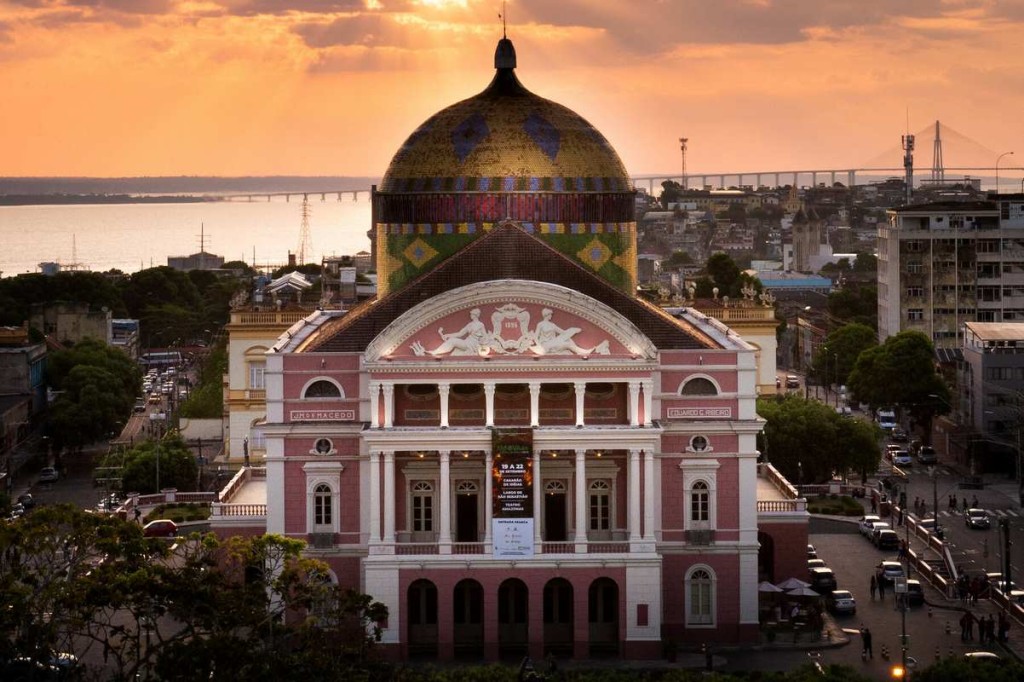
Inside the building is dripping with European craftsmanship. The theatre’s architectural style is considered typically Renaissance Revival. The roofing tiles were imported from Alsace, the steel walls from Glasgow, Scotland and the Carrara marble for the stairs, statues, and columns, from Italy.
The dome is covered with 36,000 decorated ceramic tiles painted in the colors of the national flag of Brazil. The interior furnishing came from France in the Louis Quinze style. Italian artist Domenico de Angelis the Younger painted the panels that decorate the ceilings of the auditorium and of the audience chamber. The curtain, with its painting “Meeting of the Waters”, was originally created in Paris by Crispim do Amaral. The theatre’s 198 chandeliers were imported from Italy, including 32 of Murano glass.
MORE Good News on this Date:
- Galileo Galilei observed the four largest moons of Jupiter for the first time and named them, so the four are known as the Galilean moons (1610)
- Frenchman Jean-Pierre Blanchard and Bostonian John Jeffries used a balloon to complete the first aerial crossing of the English Channel (1785)
- George Gershwin completed Rhapsody in Blue (1924)
- The First transatlantic telephone call was made from New York City to London (1927)
- The Harlem Globetrotters played their first basketball game and would combine athleticism and comedy to create a world renown traveling show (1927)
Happy 67th birthday to Katie Couric, the television news anchor and talk show host who has been called “America’s Sweetheart”. She was featured in GNN in 2016 for voluntarily cutting her pay by a million dollars to save dozens of jobs. Her 2012 book, The Best Advice I Ever Got: Lessons from Extraordinary Lives, became a New York Times best-seller.
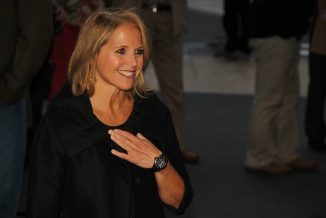
Couric has been a host on the “Big Three” American television networks, ABC, CBS, and NBC. She has also produced numerous documentaries for Sixty Minutes and other networks including Fed Up, a look into the obesity epidemic in America. In 2006 she was named anchor of CBS Evening News, becoming the first solo female anchor of the “Big Three” weekday nightly news broadcasts.
Losing her husband John to colorectal cancer in 1998 and her sister Emily to pancreatic cancer in 2001, Couric became an exceptionally influential voice in raising cancer awareness. After she used her position as 15-year anchor of Today to broadcast herself getting a colonoscopy in 2000 and a mammogram in 2005, scientists determined that the “Couric Effect” led many people to get cancer screenings who would not have otherwise done so.
Winning multiple television awards throughout her career as a broadcaster, she collected a Peabody Award, one of the highest for journalism in the country, especially for her series Confronting Colon Cancer. (1957)
Also, heavy metal metastasized in mainstream music 53 years ago today with Black Sabbath’s release of Paranoid. Containing some of the band and genre’s most iconic tracks such as War Pigs, Iron Man, and Paranoid, it would go on to settle ten million arguments about what the first heavy metal album was.
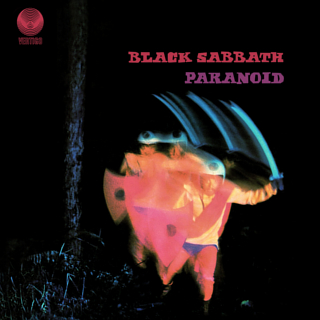
Selling 4.5 million copies worldwide, the album contained many topical references to the Vietnam War, which the band opposed. However it was pressure from the record company to avoid backlash that saw the album’s name changed from War Pigs to Paranoid.
“What… does a bloke dressed as a pig with a sword in his hand got to do with being paranoid, I don’t know, but they decided to change the album title without changing the artwork,” Osbourne said in 1998.
And, 26 years ago today, the Canadian government in an elaborate ceremony formally apologized for the first time to the nation’s indigenous peoples for past acts of oppression.
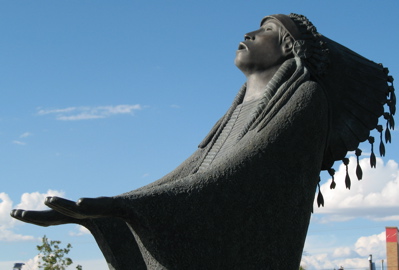 They pledged $245 million in counseling and treatment programs for the thousands of Indians who were taken from their homes and forced to attend abusive school programs–and pledged other money for economic development. It was one tiny step to heal the pain of Canada’s aboriginal population, which include Inuits and numbers 810,000. Prime Minister Stephen Harper also apologized formally in 2008 (pictured above), this time in the House of Commons chamber. That official expression of regret included $1.9 billion in compensation for victims of the “residential schools” program that were operating in 130 locations nationwide, some for more than a century; and established a truth and reconciliation commission to examine the religious schools’ legacy. (1998)
They pledged $245 million in counseling and treatment programs for the thousands of Indians who were taken from their homes and forced to attend abusive school programs–and pledged other money for economic development. It was one tiny step to heal the pain of Canada’s aboriginal population, which include Inuits and numbers 810,000. Prime Minister Stephen Harper also apologized formally in 2008 (pictured above), this time in the House of Commons chamber. That official expression of regret included $1.9 billion in compensation for victims of the “residential schools” program that were operating in 130 locations nationwide, some for more than a century; and established a truth and reconciliation commission to examine the religious schools’ legacy. (1998)
Happy 74th Birthday to singer-songwriter and guitarist Kenny Loggins. His singles include Danny’s Song, This is It, and Angry Eyes from his band Loggins and Messina. A stellar solo career—with hits like Heart to Heart and Return to Pooh Corner—included 12 platinum-selling albums and two Grammy awards. He also recorded multiple successful hits for film soundtracks in the 90s, like I’m Alright from Caddyshack, Danger Zone from Top Gun, and Footloose. Kenny also made Footloose into a children’s book. WATCH an interview… (1948)
67 years ago today, singer Marian Anderson made her debut with the Metropolitan Opera in New York City, becoming the first black performer ever to take the stage as a member. Her vibrant contralto performance as Ulrica in Giuseppe Verdi’s Un ballo in maschera at the Met was the only time she sang an opera role on stage, declining other opportunities because she had no actor training. She did, however, perform opera arias at her concerts, alongside a repertoire of traditional American songs and spirituals.
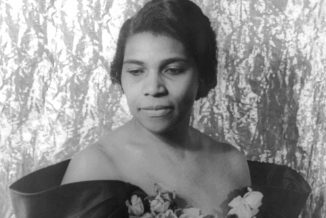 Although her family could not afford singing lessons or even a high school education, church leaders and African-Americans in Philadelphia who admired Marian Anderson’s many choir performances raised the money needed to send her to music school.
Although her family could not afford singing lessons or even a high school education, church leaders and African-Americans in Philadelphia who admired Marian Anderson’s many choir performances raised the money needed to send her to music school.
Anderson also worked for several years as a delegate to the United Nations Human Rights Committee and as a goodwill ambassador for the U.S. State Department, giving concerts all over the world. She participated in the civil rights movement in the 1960s, singing at the 1963 March on Washington for Jobs and Freedom. WATCH a historical newsreel… (1955)
134 years ago today, the African American inventor William B. Purvis received a U.S. patent for his fountain pen. The businessman received multiple patents in the late 1800s, including a close-conduit electric railway system, later installed in New Jersey, and an improvement to the hand ink stamp, that allowed its own ink to be replenished.
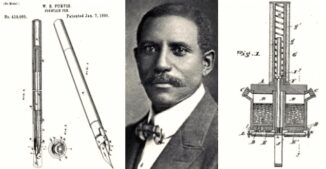
His updated design of the fountain pen was intended to provide a simple, durable, and cheaper construction so the pen could be carried in someone’s pocket. Purvis set an elastic tube between the pen nib and the ink reservoir, enabling the tube to return the excess ink to the reservoir. After his design improvement, the new pen could evenly distribute the ink when being used. (1890)
SHARE the Memories, Milestones, and Music…




















